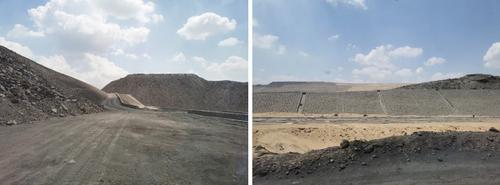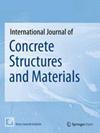冻融循环作用下煤矸石混合浮石骨料混凝土损伤劣化机理
IF 3.6
3区 工程技术
Q1 CONSTRUCTION & BUILDING TECHNOLOGY
International Journal of Concrete Structures and Materials
Pub Date : 2023-11-15
DOI:10.1186/s40069-023-00619-y
引用次数: 0
摘要
摘要:世界面临着天然砂石资源枯竭的问题,中国内蒙古产生了大量的煤矸石固体废弃物,利用率低,造成生态污染。为了提高煤矸石在矿山基础设施建设中的广泛应用前景,采用煤矸石作为浮石混凝土的粗骨料具有重要意义。内蒙古是寒冷地区,煤矸石混合骨料混凝土必然面临冻融循环的破坏。因此,设计矸石以不同体积替代率(0%、20%、40%、60%、80%、100%)替代浮石粗骨料。结果表明:随着脉石取代率的增加,MFC的质量损失率、相对动弹性模量和峰值应力均减小,而峰值应变呈增大趋势;这主要是由于脉石中Al 2o3和sio2含量较少,使得MFC水化产物随着取代率的增加而减少,试样中原始微裂纹和孔隙增多。利用威布尔统计分布理论和LEMAITRE等效效应变分假设原理建立了MFC的损伤模型,并结合实验结果探讨了损伤演化特征。为MFC在寒冷地区的应用提供了理论依据。本文章由计算机程序翻译,如有差异,请以英文原文为准。

Damage and Deterioration Mechanism of Coal Gangue Mixed Pumice Aggregate Concrete Under Freeze–Thaw Cycles
Abstract The world is facing the problem of depletion of natural sand and gravel resources, and a large amount of coal gangue solid waste is produced in Inner Mongolia, China, which has low utilization rate and causes ecological pollution. In order to improve the gangue in the mining infrastructure construction of a wide range of application prospects, the use of coal gangue as the coarse aggregate of pumice concrete is of great significance. Inner Mongolia is a cold region, and gangue mixed aggregate concrete (MFC) will certainly face the damage caused by freeze–thaw cycles. Therefore, design gangue by different volume replacement rate (0%, 20%, 40%, 60%, 80%, 100%) to replace pumice coarse aggregate. The results show that with the increase of gangue substitution rate, the mass loss rate, relative dynamic elastic modulus, and peak stress of MFC decrease, but the trend of peak strain increases. It is mainly attributed to the less Al 2 O 3 and SiO 2 content of gangue, which makes the MFC hydration products decrease with the increase of substitution rate and more original microcracks and pores in the specimens. In addition, the damage model of MFC was established by using Weibull statistical distribution theory and the principle of LEMAITRE equivalent effect variation assumption, and the damage evolution characteristics were explored by combining the experimental results. It can provide the theoretical basis for the application of MFC in cold regions.
求助全文
通过发布文献求助,成功后即可免费获取论文全文。
去求助
来源期刊

International Journal of Concrete Structures and Materials
CONSTRUCTION & BUILDING TECHNOLOGY-ENGINEERING, CIVIL
CiteScore
6.30
自引率
5.90%
发文量
61
审稿时长
13 weeks
期刊介绍:
The International Journal of Concrete Structures and Materials (IJCSM) provides a forum targeted for engineers and scientists around the globe to present and discuss various topics related to concrete, concrete structures and other applied materials incorporating cement cementitious binder, and polymer or fiber in conjunction with concrete. These forums give participants an opportunity to contribute their knowledge for the advancement of society. Topics include, but are not limited to, research results on
Properties and performance of concrete and concrete structures
Advanced and improved experimental techniques
Latest modelling methods
Possible improvement and enhancement of concrete properties
Structural and microstructural characterization
Concrete applications
Fiber reinforced concrete technology
Concrete waste management.
 求助内容:
求助内容: 应助结果提醒方式:
应助结果提醒方式:


